
THE PERIODIC TABLE OF THE ELEMENTS
OF
GREEN AND SUSTAINABLE CHEMISTRY
Paul T. Anastas
Julie B. Zimmerman
The Periodic Table of the Elements of Green and Sustainable Chemistry
Copyright © 2019
by
Paul T. Anastas and Julie B. Zimmerman
All rights reserved. Printed in the United States of America. No part of this book may
be used or reproduced in any manner whatsoever without written permission except
in the case of brief quotations embodied in critical articles or reviews.
For information and contact; address www.website.com
Published by Press Zero, Madison, Connecticut USA 06443
Cover Design by Paul T. Anastas
ISBN: 978-1-7345463-0-9
First Edition: January 2020
10 9 8 7 6 5 4 3 2 1
The Periodic Table of the Elements of Green and Sustainable Chemistry
3
To Kennedy and Aquinnah
The Periodic Table of the Elements of Green and Sustainable Chemistry
4
Acknowledgements
The authors wish to thank the entirety of the international green chemistry community for their
efforts in creating a sustainable tomorrow.
The authors would also like to thank Dr. Evan Beach for his thoughtful and constructive
contributions during the editing of this volume, Ms. Kimberly Chapman for her work on the
graphics for the table. In addition, the authors would like to thank the Royal Society of Chemistry
for their continued support for the field of green chemistry.
The Periodic Table of the Elements of Green and Sustainable Chemistry
5
Table of Contents
Preface ............................................................................................................................................................................... 7
Introduction .......................................................................................................................................................................9
Humanitarian Elements .............................................................................................................................................. 10
Green Chemistry and Green Engineering ..............................................................................................................24
Prevent Waste .............................................................................................................................................................. 26
Atom Economy ............................................................................................................................................................... 31
Less Hazardous Synthesis ....................................................................................................................................... 36
Molecular Design ..........................................................................................................................................................41
Solvents/Auxiliary Chemicals .................................................................................................................................. 46
Energy ............................................................................................................................................................................... 51
Renewable Feedstocks .............................................................................................................................................. 56
Catalysis .......................................................................................................................................................................... 61
Degradation ...................................................................................................................................................................66
Measurement and Awareness ...................................................................................................................................71
The Periodic Table of the Elements of Green and Sustainable Chemistry
6
Enabling Systems Conditions ...................................................................................................................................76
Conceptual Frameworks .............................................................................................................................................78
Economics and Market Forces ................................................................................................................................. 85
Metrics ............................................................................................................................................................................ 92
Policies and Regulations ...........................................................................................................................................99
Tools............................................................................................................................................................................... 106
Noble Elements ............................................................................................................................................................ 113
Valency ..........................................................................................................................................................................122
Conclusion ....................................................................................................................................................................123
Bibliography ................................................................................................................................................................. 124
The Periodic Table of the Elements of Green and Sustainable Chemistry
7
Preface
The field of Green Chemistry emerged in the early 1990s as an approach to using the power
and potential of chemistry to design the next generation of products and processes such that
they are good for humans, the environment, society, and the economy. Its innovations are felt
around the world in improving the products of our daily lives, the way we make our medicines
and grow our food, and how we generate and store our energy. In recent years, sustainable
chemistry has been introduced to describe those important aspects beyond the science that
are necessary for green chemistry to make a positive impact on the world at the scale and
timeframe necessary to advance sustainability.
In celebration of the 150th anniversary of the Periodic Table of the Elements, a new metaphorical
construct has been assembled to illustrate the “elements” that will be crucial on the path to
a sustainable future. This is the basis of “The Periodic Table of the Elements of Green and
Sustainable Chemistry.”
The Periodic Table of the Elements of Green and Sustainable Chemistry

8
The Periodic Table of the Elements of Green and Sustainable Chemistry

9
Introduction
When thinking about the brilliance of how creative chemistry has transformed civilizations in
terms of volume and efficiency of food production, access to energy, invention of new medicines,
ability to travel far distances, and the insights gained through its role in the information revolution,
one soon recognizes why chemistry is often referred to as “the central science”. But certainly,
it is not merely central to various industrial sectors or central to enabling a range of academic
disciplines. It must be central to more than just that.
What it is central to is perhaps the most important question of our time. Because when recognizing
the fundamental nature and the power of chemistry, we recognize that it is central to whether
we will meet the greatest challenges of current and future generations. When considering the
great urgent goals of sustainability, chemistry is central to the difference between success and
failure, survival and extinction. It is that fundamental.
In recent decades, the field of green chemistry has emerged with all of its technological and
commercial achievements, with all of the new perspectives that green chemistry brings, all of
the new inventions and innovations, new reactions and transformations of forms of matter, and
the motivation and impetus behind all of this activity becomes clear. We find the answer to the
question: “Why do we do what we do?”
And at the foundation of everything we do are the humanitarian issues, the humanitarian goals,
the human species and the ecosystems, biosphere, and geosphere upon which the human
species relies.
The Periodic Table of the Elements of Green and Sustainable Chemistry

10
The Periodic Table of the Elements of Green and Sustainable Chemistry
Humanitarian Elements
The following elements of Green and Sustainable Chemistry emphasize
core humanitarian aims and principles. Since chemistry has existed as a
discipline, it has played a central role in meeting fundamental human needs.
As we continue to press against the limits of natural systems, it will remain
a challenge to ensure basic needs such as food, water, security, and shelter
for future generations. Green and Sustainable Chemistry should also strive
to ensure that risks and benefits are equally shared among populations.

11
The Periodic Table of the Elements of Green and Sustainable Chemistry
Appropriate Technologies for the Developing World
The invention and deployment of chemical technologies over the past
two centuries has transformed modern life for a segment of the global
population. However, many of the technologies developed in the past and
still being developed today are not benefiting or improving the well-being
of a large percentage of the world’s population. This is due to factors that
include particular resource flows, capital flows, infrastructure requirements,
human capital, and more.
Developing appropriate technologies means understanding the context in
which a technology will be deployed to ensure that it can bring benefit.
Designing a technology to be viable in the industrialized world or the
developing world, a major metropolis or a tribal village, requires systems
thinking and thoughtful design. Designing technologies for the appropriate
context is a challenge that needs to be met if benefit is to be equitable.

12
The Periodic Table of the Elements of Green and Sustainable Chemistry
Chemistry for Wellness
Chemistry has been at the forefront of modern Western medicines with
the vast majority of effort focused on treating disease. However, treating
disease is not the same as preserving wellness. Chemistry has been at
the forefront of increased food production. However, increased food supply
and production of caloric content is not the same as the realization of
access to nutritional health. Chemistry has been at the forefront of imaging,
diagnostics, and sensors but measuring and monitoring a problem is not the
same as solving it or preventing it. Chemistry can play a role in significant
and timely efforts to rigorously understand and deliver nutraceuticals,
probiotics, and other beneficial supplements. Chemists also need to work
toward elucidating and enhancing positive mechanistic pathways toward
proactive health.

13
The Periodic Table of the Elements of Green and Sustainable Chemistry
Access to Safe and Reliable Water
One of the essential materials of life is water. Access to suitable water for
drinking, sanitation, and hygiene is necessary for life, health, and well-being.
Chemistry has been critical in historical approaches to water disinfection
and improving water quality from removal of harmful contaminants to
addressing odor and taste concerns. Chemistry will be required to realize the
future methods, process, and materials that enable healthful drinking water
without the unintended consequences of harmful disinfection by-products.
Sanitation is an equally important imperative to avoid the spread of disease
by exposure to pathogens. These services must be supplied in ways that
are mindful of equity, safety, and dignity. The enabling infrastructure and
processes for supply and treatment of potable and non-potable water will
all depend on chemical innovations to ensure appropriate quantity and
quality for drinking, sanitation, hygiene, or any other intended use.

14
The Periodic Table of the Elements of Green and Sustainable Chemistry
Chemistry for Benign Food Production and Nutrition
While the great increases in the efficiency of food production have been
astounding and life-saving, there have been unintended consequences
from the over-use of fertilizers and the use of pesticides and herbicides that
harm beneficial insects and plants and damage ecosystems.
Chemical and non-chemical alternatives are being developed and need to
be implemented at larger scale. These range from targeted bio-pesticides
to herbicides that focus on specific pests and plants to pesticides designed
to degrade rapidly into non-toxic degradation products. Integrated pest
management systems have been shown to be efficacious and economically
practical without the environmental damage.

15
The Periodic Table of the Elements of Green and Sustainable Chemistry
Ensure Environmental Justice, Security, and Equitable
Opportunities
Proximity to chemical manufacturing, processing, and use has historically
come with disproportionate risk to the surrounding communities and
ecosystems; this includes the exportation of banned chemicals and
hazardous waste to communities with few other economic opportunities.
Individuals should have the right to live in homes and communities that are
not placed at increased risk due to transportation or production of chemicals
or inadequate protection of facilities. Use of highly hazardous chemicals
increases vulnerability to accidents, natural disasters, or intentional acts of
violence and terror. Adopting chemistries that are inherently benign is the
most effective means of ensuring that communities are not placed at undue
risk from the chemical enterprise. Case studies have shown that there are
safer alternatives to toxic gases, VOCs, pesticides, and cleaning chemicals
implicated in previous incidents.

16
The Periodic Table of the Elements of Green and Sustainable Chemistry
Chemistry to Preserve Natural Carbon and Other
Biogeochemical Cycles
Integrated systems are the basis of the planet’s natural biogeochemical
cycles. From carbon to nitrogen to water and beyond, these chemical cycles
and chemical processes are adversely impacted by the human interferences
and interactions with these cycles. Human chemistry must be designed
such that there will be no perturbation of the natural biogeochemical cycles
and their interlinkages. Through thoughtful consideration of human material
and energy utilization, we can protect the critical natural cycles essential to
the preservation of life and all of its diversity on the planet.

17
The Periodic Table of the Elements of Green and Sustainable Chemistry
No Chemicals of War or Oppression
The history of the intentional use of weaponized chemicals is recognized
as uncivilized and the continuation of the universal rejection of this practice
is essential to a civilized society. Likewise, the use of chemicals for carrying
out the death penalty or for the oppression of individuals through chemical
lobotomies or chemical castration must not happen. Designing, making,
and utilizing chemicals for the purpose of mental or physical control over
individuals is inconsistent with the peaceful uses of chemistry.

18
The Periodic Table of the Elements of Green and Sustainable Chemistry
Design to Avoid Dependency
Some molecules can be addictive to humans. They can cause physical
and neurological changes that result in dependency, and its subsequent
impairment. Chemists have the duty to establish knowledge and awareness
of the mechanisms of dependency in order to ensure that the molecules
that are created do not result in human dependency and addiction.
Economic dependency is a separate yet important issue. Molecules should
not be designed to be essential and inseparable to livelihood and wellness
and embedded in systems that provide critical items like food, clean water,
and medicine.
Chemical dependency is not limited to the human species; it can also
impact other living things both animal and plant. Dependency needs to be
understood such that design for variety and resilience is pursued preferably.

19
The Periodic Table of the Elements of Green and Sustainable Chemistry
Ensure Access to Material Resources for Future Generations
The basic elements will largely not be created nor destroyed – with the
exception of radioactive decay. However, the ability to access resources
that are fundamental to the chemical and material infrastructure of our
society and economy can be greatly impacted and diminished through
irresponsible use. The combustion of valuable fossil fuels, the dissipation of
phosphorus, and the diffusion of rare earth elements will make our resource
base more difficult to access for future generations.

20
The Periodic Table of the Elements of Green and Sustainable Chemistry
Transparency for Chemical Communication
The potential benefits and the potential harm that can be provided by
chemistry are too immense and powerful to be cloaked in the darkness
of jargon. Yet, as the evolution of chemistry proceeds, the greater the
opacity of the science to the general public. The responsibility of molecular
scientists – and scientists generally – is not merely to discover, invent, and
understand, but also to effectively convey that understanding as clearly
and transparently as possible. To be clear, this is not the same as “as
clearly and transparently as convenient.” The task of communication is
not a secondary task but rather one of equal status in the scientific pursuit.

21
The Periodic Table of the Elements of Green and Sustainable Chemistry
Chemistry for Sustainable Building and Buildings
The structures that are used to house people and their activities should
be designed, constructed, and maintained to provide resilient protection
while being conducive to the health and wellness of the occupants and
the surrounding ecosystems. From the molecular basis of the materials
throughout their life cycle to the systems that provide the requisite water,
climate control, and lighting, chemistry has a significant role to play in
efficiently providing safe indoor environments for humans and their activities
while considering the surrounding landscape. Further, buildings can be
designed to be modular, providing for future adaptions, deconstruction, and
reuse to avoid end of life material waste.

22
The Periodic Table of the Elements of Green and Sustainable Chemistry
An Individual’s Molecular Code Belongs to that Individual
Every individual possesses the unique molecular code that is the underlying
basis of their individuality and their identity. Further, this code has the power
and potential for understanding health and wellness in a fundamental way,
at the molecular scale. While this molecular code may contain information
and functionality that can result in value, every individual is sovereign over
their code and this sovereignty cannot be taken from them by others. As
the ability to understand, manipulate, and utilize the various levels of this
biological code increases, it will be ever more essential to guarantee that
control of this code remains with the individual.

23
The Periodic Table of the Elements of Green and Sustainable Chemistry
Molecular Codes of Nature Belong to the World
No human wrote any of the genetic codes of Nature and no human or group
of humans can own it. Humans played no role in the billions of years of the
design of genomes, bio/geo material structure, natural transformations and
self-assembly. The inventions of Nature belong to Nature. The codes of
Nature belong to Nature. The act of a human recognizing its brilliance and
deeming it a discovery is not justification to claiming ownership and control
or in any way limiting access to this brilliance by everyone.
24
The Periodic Table of the Elements of Green and Sustainable Chemistry
Green Chemistry and Green Engineering
In order to address the humanitarian goals that are inextricably linked to preserving our natural
world, invention and innovation are essential. While efficiency will be necessary, it will be far
from sufficient. Efficiency will help you do the thing you are doing better; it will not help you do
a better thing. Being more efficient in our use of unsustainable resources, products, processes,
and systems is not going to fundamentally alter the unsustainable trajectory we are on. Doing
something that is unsustainable more efficiently does not make it sustainable.
The design, invention, and innovation that is required is embedded in the Principles of Green
Chemistry and Green Engineering. The scientific and technological breakthroughs using these
principles are meant to change the nature and character of the material basis of our society and
our economy – including the materials used to generate, store, and transport our energy – to
make it healthful rather than toxic, renewable rather than depleting, and restorative rather than
degrading. The manifestation of these principles are the discoveries that go from the laboratory
to making a difference in the world.

25
The Periodic Table of the Elements of Green and Sustainable Chemistry
This collection of science and technology is the manifestation of the Twelve Principles of Green
Chemistry and the Twelve Principles of Green Engineering.

26
The Periodic Table of the Elements of Green and Sustainable Chemistry
Prevent Waste
Regardless of its nature, waste consumes resources, time, effort, and
money both when it is created and then when it is handled and managed
at end of life, with hazardous waste requiring even greater investments for
monitoring and control. Creating, handling, storing, and disposing of waste
is necessarily an expense and does not add value in terms of innovation
or performance. In processes of production, therefore, waste is always
undesirable in any form.
Ideally, molecules, products, processes and systems would be designed
to not create waste. We should aim to eliminate even the concept of
waste by ensuring that all outputs are feedstocks elsewhere, mimicking
natural systems. Whether the waste is material, energy, space, time, or the
derivative of all of these, money, there are design strategies that can and
are being implemented in Green Chemistry and Engineering to address the
issue at the most fundamental level: prevention.

27
The Periodic Table of the Elements of Green and Sustainable Chemistry
Waste Material Utilization and Valorization
Waste is a human-centered concept. In Nature there is, for all practical
purposes, no waste. In Nature, organisms and geo-systems evolve
to utilize the “waste” of one process to nourish, sustain, and strengthen
another. While the history of human-designed chemical systems has been
linear (e.g., take-make-waste), there is a recognition that genuine elegance
requires the building of circular systems where materials and energy flow
in cycles as they do in Nature. This depends on developing the tools,
techniques, and approaches for “designing waste” such that the “waste”
itself is considered an additional product of the system.
These approaches of chemical waste valorization have found large-scale
application in a variety of settings from individual product manufacturing
processes to entire mega-scale factories to urban and regional networks.
Transforming waste into a value-added product is a science in its infancy
and it will need to develop considerably in sophistication and scale in order
to displace the wasteful linear processes that have historically dominated.

28
The Periodic Table of the Elements of Green and Sustainable Chemistry
“One-Pot” Synthesis
When chemical transformations have taken place historically, they have
often required many steps, especially for complex molecules such as those
in the field of pharmaceuticals. Each time there is a multi-step synthesis,
there is the need for separation, isolation, and purification that results in loss
of material, increased energy usage, and time lost.
Where possible, chemists should aim to design “one-pot” synthesis, in
other words, transformations that can be carried out in a single reaction
vessel without isolation, purification, or other wasteful steps. These more
efficient processes must also avoid potential tradeoffs such as relying
on more toxic substances or generating lower quality products. When
implemented carefully, fewer steps and fewer reaction vessels can provide
significant benefits in efficiency and waste reduction.

29
The Periodic Table of the Elements of Green and Sustainable Chemistry
Process Intensification
Traditional methods of chemical manufacturing have intrinsic inefficiencies
that result in wastes of materials, energy, time, and space. Through
thoughtful redesign, entire manufacturing processes that had been split into
large numbers of “unit processes” of reaction, separation, purification, etc.,
can be combined. The benefit is not merely waste reduction but also lower
capital and operating costs while increasing inherent safety. The concept of
having small continuous-flow “reactors” that can be increased in number,
so-called “numbering up,” can realize these advantages compared to
conventional “scaling up” of bulk processes.

30
The Periodic Table of the Elements of Green and Sustainable Chemistry
Self-Separation
The chemicals and materials enterprise is one of the major consumers
of energy in industry. One very large piece of this energy consumption
comes from separation processes, encompassing isolation, purification,
and some kinds of cleaning. In addition to the energy that is directly input
into traditional separation systems, the dependency of these processes on
large volumes of solvents also consumes significant amounts of embedded
energy from solvent manufacturing and purification.
Systems designed to facilitate “self-separation” can decrease energy and
material usage when developed properly. Designing a molecular product
to separate from its reaction matrix or enabling an impurity generated in
a process to self-separate due to intrinsic factors can have sustainability
advantages.

31
The Periodic Table of the Elements of Green and Sustainable Chemistry
Atom Economy
The modern miracle of chemical enterprise is the ability to transform
the materials that occur naturally in the world into new materials with
new properties and performance that would not otherwise exist. History
has shown there are thoughtful and wise ways to engage in molecular
transformation and there are methods that are profoundly toxic, wasteful,
and depleting. The new emerging synthetic methods that have been
demonstrated in the field of green chemistry come from thoughtful life-
cycle design and often use Nature and biological systems as an inspiration,
mentor, and guide. Through this type of thoughtful design, we move from a
narrow definition of mere efficiency to one of holistic productivity.
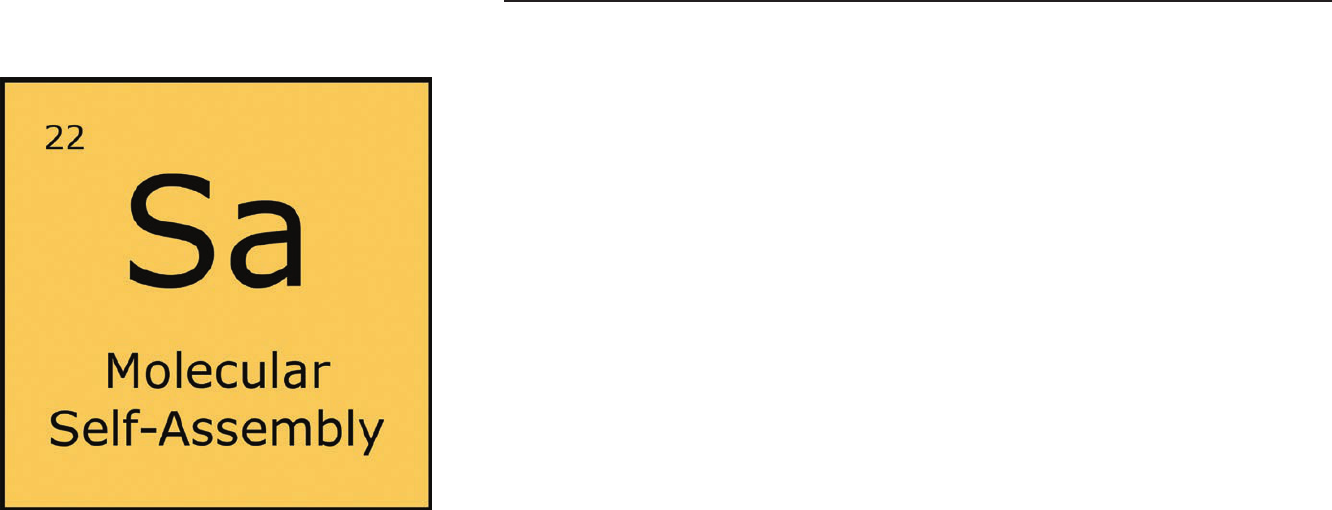
32
The Periodic Table of the Elements of Green and Sustainable Chemistry
Molecular Self-Assembly
The process of intentional bond-making has been one of the most important
accomplishments of chemistry. Historically, this process has often been
forced through the use of energy or reactive reagents to occur at the time,
place, and rate that is desired. The more complex the molecule, the more
steps and energy that has often been employed.
Looking at natural and biological systems, there are many examples where
complex molecules with extensive stereochemistry and intricate ring
systems are realized through molecular self-assembly that takes place
upon appropriate stimulus. This can be achieved in human-designed
synthesis as well. It is, of course, always important to not simply design
a self-assembling molecule by shifting the energy and reagent inputs to
another part of the product life-cycle such as its precursors.

33
The Periodic Table of the Elements of Green and Sustainable Chemistry
Integrated Processes
Long chains of unit reaction processes accumulate energy and material
waste due to the separation, isolation, and purification steps usually
encountered after each step. These transitions are among the most
energy-intensive aspects of an overall process. There are almost always
material losses due to transfer from a reactor to another process step. By
designing processes to be integrated to the highest feasible degree, there
can be significant advantages not only for energy and material efficiencies,
but also for the time saved and reduced exposures to chemical workers.
It can be valuable to integrate not only individual processes but numerous
processes as well to accomplish goals such as utilization of waste heat/
material from one process as a feedstock for another.

34
The Periodic Table of the Elements of Green and Sustainable Chemistry
Additive Synthesis
The use of addition reactions can significantly decrease intrinsic waste
generated by the synthetic method. By building up a molecule atom by
atom or fragment by fragment, chemists use only what is necessary in
constructing the target. It is essential to be thoughtful about not simply
shifting the burden of waste from one step to another step or another part
of the process, but wisely employing addition reactions has benefits over
elimination and substitution reactions that inherently generate waste as
part of the nature of the reaction.
Conceptually, the addition reaction can be translated beyond the molecular
scale. For example, additive manufacturing is similarly beneficial for larger
scale material assembly and applications.

35
The Periodic Table of the Elements of Green and Sustainable Chemistry
Non-Covalent Derivatives / Weak Force Transformation
Chemists have pursued the mastery of bond-making with for more than
200 years with great success. However, we should note that Nature
accomplishes impressive functional modifications and performance
not only through covalent bonds but also extensively using weak-force
interactions. These weak forces engage at the time and place necessary to
impart useful properties precisely when and where they are needed. Weak
forces guide many bond-forming pathways in Nature.
While humans have been increasingly aware of the essential importance
of weak forces, there is a need for greater mastery of these powerful tools
such that they can be used as design levers to achieve function and
performance with minimal harm to the environment.

36
The Periodic Table of the Elements of Green and Sustainable Chemistry
Less Hazardous Synthesis
While efficiency has historically served as a proxy for sustainable practices
in the chemical enterprise, it is imperative that the goal of reducing
the quantity of material and energy consumed is closely coupled with
considerations related to the nature of that material and energy. Using
less may not have the beneficial effects of reducing the overall hazard of
the synthetic process depending on the nature of the feedstocks, reagents,
and auxiliary chemicals. It is imperative that these inputs and outputs,
in addition to the intended product, are as inherently benign as possible.
Further, the conditions under which synthetic processes are carried out
should be considered when pursuing the goal of a more sustainable
chemical enterprise. This offers benefits from environmental and human
health perspectives in addition to a reduction in vulnerability to chemical
accidents and sabotage.

37
The Periodic Table of the Elements of Green and Sustainable Chemistry
Reduce Use of Hazardous Materials
It is more impactful to design for reduced hazard than for controlling
exposures. The use of hazards – physical (e.g., corrosivity, reactivity,
explosivity, flammability), toxicological (carcinogenicity, reproductive and
developmental including endocrine disruption, neurological), or global (e.g.,
ozone depletion, greenhouse gases) – can be minimized or eliminated
throughout the entire life-cycle of a chemical process. The approach
applies to feedstocks, reagents, solvents, catalysts, byproducts, and the
products themselves. New or alternative chemicals should be rationally
designed for reduced hazard or, at a minimum, assessed and understood
to have reduced hazard by comparison to materials being substituted, to
minimize these negative environmental and human health consequences.

38
The Periodic Table of the Elements of Green and Sustainable Chemistry
In-Situ Generation and Consumption of Hazardous
Materials
Reactivity is an essential part of chemical transformations and is also
closely associated with the hazardous nature of many substances. One
strategy that can be employed to avoid exposure of workers or nearby
communities to toxic/reactive reagents, is to generate and consume them
in the processes without any significant accumulation of these substances.
Through “in-situ” generation, the substance needs only to be generated in
minuscule quantities for short amounts of time as it is needed before it has
consumed that reaction.

39
The Periodic Table of the Elements of Green and Sustainable Chemistry
C-H Bond Functionalization
Organic chemistry creates new molecules by forming carbon-carbon (C-
C) bonds. Most processes use raw materials with carbon-hydrogen (C-H)
bonds and, to avoid side products, making the desirable connections often
takes an indirect, roundabout route to avoid side products. The conventional
chemistry toolbox includes substitution and elimination reactions that
generate waste at the molecular level, adding to the process complexity
as well as environmental burdens. Direct C-H activation through catalysis
enables addition or rearrangement mechanisms that are inherently efficient.
Continuous improvement in this area of research gives chemists more
options for cleaner chemistry without sacrificing control over the reaction or
limiting access to interesting chemical structures.

40
The Periodic Table of the Elements of Green and Sustainable Chemistry
Inherent Safety and Security
Chemists and chemical engineers know the properties, structures, and
conditions that underlie explosivity, flammability, and corrosivity. Designing
molecules such that they are not capable of ignition, conflagration,
combustion, or explosion is something that is within the skillset of chemistry
today.
While safety has been a concern of the chemical enterprise for much of
its history, this has often been accomplished through protection from the
consequences of these physical hazards when they occur rather than
through molecular design for reduction of intrinsic hazard. Upfront design
gives better protection from accidents as well as terrorism and sabotage
vulnerability.

41
The Periodic Table of the Elements of Green and Sustainable Chemistry
Molecular Design
The basis of our society and economy is synthetic chemicals and materials.
While there have been significant advances in toxicology associated with
identifying, and in some instances predicting, commercial chemicals that
are likely to cause harm to human and ecosystem health, the gains in
informing the a priori design of chemicals with reduced hazard to humans
and the environment have been elusive. To realize the goal of designing
chemicals that are safe and functionally relevant, there is a need to create
an interdisciplinary body of knowledge at the nexus of computational
chemistry, mechanistic toxicology, and big data analytics among others. It
is only when we change the inherent nature of the chemicals and materials
that are foundational to quality of life that we can truly advance toward
a sustainable future that is no longer reliant on costly regulatory and
technological controls of circumstances in which hazardous chemicals can
be used and managed.

42
The Periodic Table of the Elements of Green and Sustainable Chemistry
Design Guidelines
Design is intentional. If a chemical contains a hazard that is not intended, it
is a design flaw. Yet, many of our made-made chemicals contain hazards to
humans or the biosphere by accident or lack of thoughtful design.
As we understand the underlying basis of hazard to human health and
the environment at the molecular level, we can design to avoid it. As we
understand the properties which enable chemical accidents and other
adverse consequences, we can and must design to avoid these outcomes
where possible.

43
The Periodic Table of the Elements of Green and Sustainable Chemistry
Computational Models
With increasingly deeper molecular-level understanding of the nature of
chemical hazard comes increased potential for the use of computational
models to assess, predict, and design out hazards from the chemicals we
use and produce. The wide range of physical/chemical properties that are
the underlying basis for toxic mechanisms of action, exposure pathways,
and transport and fate can be evaluated in-silico with greater accuracy
and the insights derived from these evaluations can be used to avoid the
adverse consequences that have marked the less-desirable aspects of the
history of the chemical enterprise.

44
The Periodic Table of the Elements of Green and Sustainable Chemistry
Bioavailability / ADME
At the foundation of protecting living things from toxicological impacts is
the concept of ADME (absorption, distribution, metabolism, excretion),
describing how chemicals behave in and are changed within an organism.
By understanding the molecular parameters that control the stages of
ADME, chemists can control a chemical’s bioavailability—its ability to
access a biological system. The insights from pharmaceutical research in
trying to maximize bioavailability have provided intellectual tools that can
be used in all aspects of the chemical enterprise in thoughtful design for
hazard reduction.

45
The Periodic Table of the Elements of Green and Sustainable Chemistry
High Throughput Screening (Empirical / In Vivo / In Vitro)
Empirical testing of the toxicity of a chemical is an essential part of the
deep understanding of the potential consequences of a chemical. As we
move away from animal testing due to ethical and financial drivers, the
development of bioassays is increasingly important. Emerging bioassays
cover a large number of biological processes and toxicological endpoints
and can be done within a high throughput framework. The extensive
amounts of data generated provide insights into the concerns that may
be associated with specific chemicals, and in aggregate have potential to
inform design guidelines for safety of future chemicals.

46
The Periodic Table of the Elements of Green and Sustainable Chemistry
Solvents/Auxiliary Chemicals
The cost, environmental impact, and safety of a chemical processes are
often driven by the solvents and other auxiliary chemicals. The amount
of solvent used often exceeds raw materials, reagents, and products,
particularly in the case of separation and purification processes. Once
again, while quantity of these chemicals is an important consideration
from a perspective of material and energy efficiency, it is the nature of our
historic solvents that has posed the greatest challenge to the environment
and human health. Conventional solvents have generally been volatile,
increasing likely exposures; hydrophobic, serving as long-term sources of
concern in environmental systems; and toxic to ecosystems and humans,
particularly notable in terms of worker exposure. Just as we aspire to
design safer chemical products, the same effort and attention should be
brought to bear on the design of safer solvents or solvent-free processes
through both improving the inherent nature of these compounds as well as
minimizing their exposure potentials.

47
The Periodic Table of the Elements of Green and Sustainable Chemistry
Aqueous and Biobased Solvents
Water is the original solvent: the solvent of life. And yet, the long history
of the chemical enterprise largely eschewed water as a solvent. As
petrochemical processes came to be dominant, it was considered logical
that organic solvents would be most compatible with hydrocarbon-based
transformations. Research launched in the 20th century but accelerating
in the 21st century has shown that water as a solvent is desirable for many
chemical processes, even those where it was once thought not possible.
Water has been shown in cases to accelerate reaction rates and enhance
selectivity. The performance gains are in addition to benefits such as non-
toxicity, non-flammability, cost-effectiveness, and ready availability in
most instances.

48
The Periodic Table of the Elements of Green and Sustainable Chemistry
Ionic Liquids / Non-Volatile Solvents
When salts can be designed to perturb their crystal structure adequately
such that they are a liquid at room temperature, they are known as room
temperature ionic liquids (RT-IL. These liquids have been demonstrated to
be effective solvents in a wide range of applications while having negligible
vapor pressure. This is important as lack of vapor pressure avoids one of
the most concerning routes of exposure for most volatile solvents, that of
respiration. Another major concern with traditional solvents is the impact
on atmospheric chemistry and air pollution. With RT-IL, this type of
atmospheric transport is not possible.
While the lack of vapor pressure is an elegant attribute for this class of
solvents, it is also critical that these solvents are designed for low toxicity.

49
The Periodic Table of the Elements of Green and Sustainable Chemistry
Sub- and Super-Critical Fluids
There are gases that, when subjected to a certain temperature and pressure
condition, known as their critical point, become materials that are neither
gas nor liquid but rather “super-critical” fluids. While these fluids have
been known for centuries, recent discoveries have renewed interest in
their excellent solvent properties. Carbon dioxide, both in a sub- and super-
critical state, has been demonstrated at large scale as a practical solvent for
everything from synthesis to extraction, cleaning, and analysis.
The green advantages of supercritical fluids are numerous including low
toxicity (for water and carbon dioxide), lack of flammability, tunability, and
the possibility of “infinite recyclability” by cycling pressure. The use of
carbon dioxide as a solvent does not require the generation of new CO2
and does not necessarily contribute to greenhouse gas emissions.

50
The Periodic Table of the Elements of Green and Sustainable Chemistry
“Smart” Solvents (Obedient, Tunable)
The ability to make a solvent respond to stimuli and change its properties
under new conditions can be extremely consequential. Historically,
solvents were energy consuming because solubility was controlled almost
exclusively through heating and cooling. With next generation solvents
that have been demonstrated and developed, solvents can be controlled
by factors such as pressure or pH.
These new so-called obedient solvents open up possibilities for niche
and industrial uses that change the energy profiles for many chemical
processes.
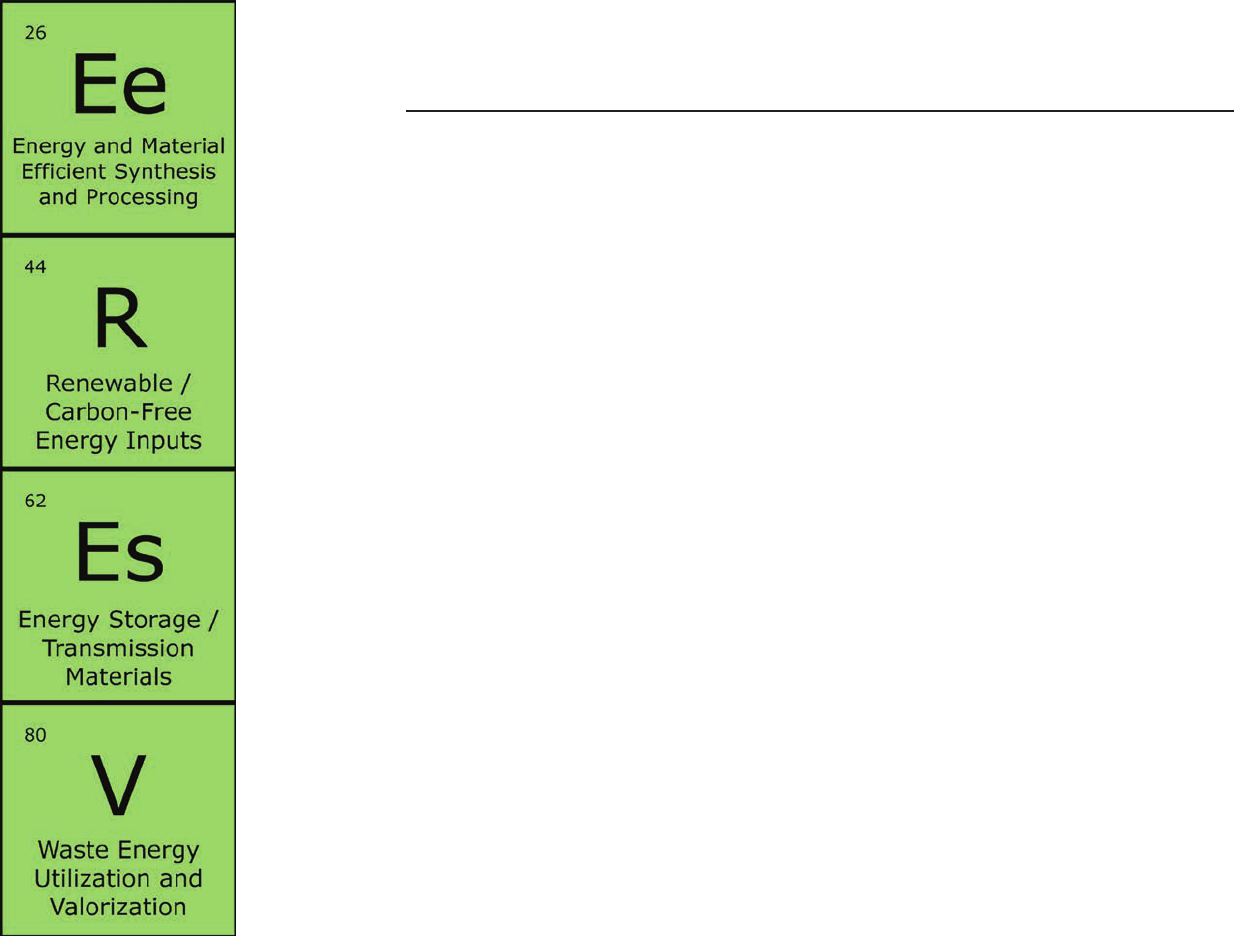
51
The Periodic Table of the Elements of Green and Sustainable Chemistry
Energy
The chemical sector consumes approximately 20% of total industrial
energy consumption in the U.S., and contributes in similar proportions to
U.S. greenhouse gas emissions. Given the reliance on fossil fuel resources
and the associated greenhouse gas emissions, there is a clear indication
that, at a minimum, the chemical enterprise should strive to be as energy
efficient as possible, normalizing to chemical function rather than mass in
the assessment. Gain in efficiency can be realized by considering both the
quantity and quality of energy inputs as well as waste energy utilization.
Of course, the chemical sector has a significant role to play in changing
the nature of our energy feedstocks toward ones that are renewable, and
developing materials that can enhance energy generation, storage, and
transmission to enable the use of these renewable energy sources.

52
The Periodic Table of the Elements of Green and Sustainable Chemistry
Energy and Material Efficient Synthesis and Processing
Synthesizing, transforming, and manufacturing raw materials into the
desired chemical products requires the input of energy to drive the reaction.
The form of this energy, in addition to the amount, has a significant impact
on the environmental cost of carrying out the reaction. There have been
recent advances to reduce the overall energy demand and subsequent
environmental and economic impacts of chemical production by exploring
different means of energy delivery including mechano-, electro-, photo-,
and electromagnetic chemical-driven transformations. These alternative
approaches can affect the amount of energy used in removal of contaminants
(purification), retrieving the desired molecules (isolation), removal of
extraneous/undesirable materials (cleaning), or breaking a complex mixture
into its components, including the removal of water (separations).

53
The Periodic Table of the Elements of Green and Sustainable Chemistry
Renewable / Carbon-Free Energy Inputs
As long as the chemical enterprise is among the largest energy consumers
of the economy, there is a responsibility to ensure that the energy consumed
is renewable and carbon-free. The options are becoming plentiful with solar
and wind becoming a larger share of the energy grid. However, it must be
recognized that all current sources of energy are not created equal in terms
of ability to be applied to manufacturing processes of all chemicals. There
will be needed advances in realizing renewable energy systems that can
deliver the kind of scale and quality demanded for chemical processing,
refining, and distillation.
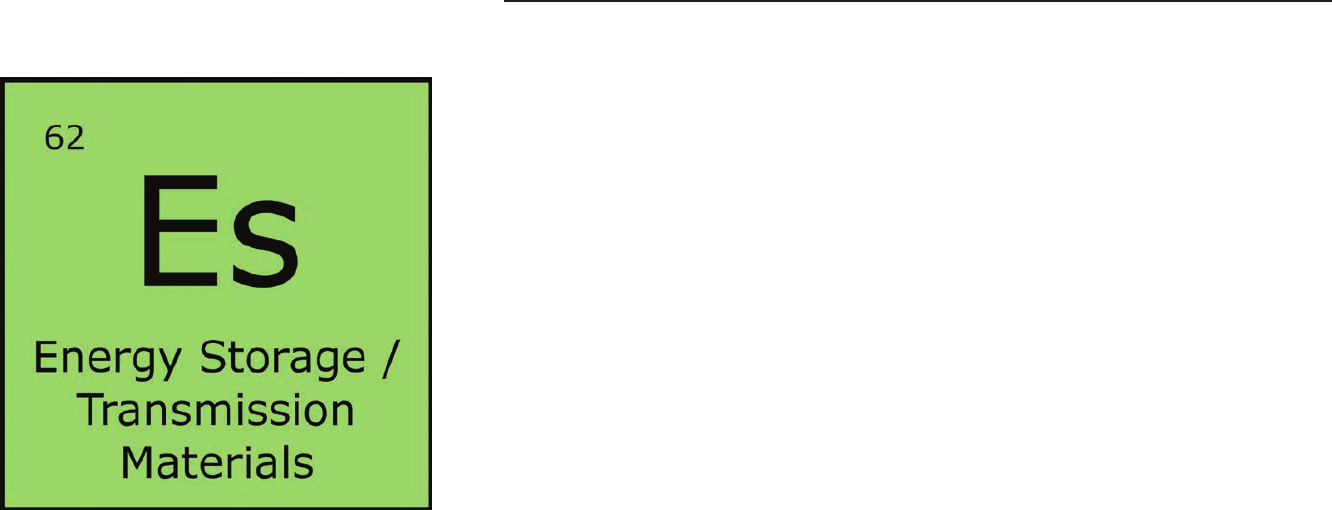
54
The Periodic Table of the Elements of Green and Sustainable Chemistry
Energy Storage and Transmission Materials
Even the most sustainable and renewable sources of energy risk going
to waste when not utilized immediately if there is not adequate ability to
store or transport this energy. Physical, mechanical, chemical, and other
methods of energy storage and transmission will require the underlying
materials to be benign and Earth abundant. Technologies such as batteries
or hydrogen storage will only be as sustainable as the materials used
throughout their life-cycles.

55
The Periodic Table of the Elements of Green and Sustainable Chemistry
Waste Energy Utilization and Valorization
Waste materials are highly noticeable when they fill up landfills around
the world or become pollution in the ocean, but much less attention is
paid to waste energy generation. Waste energy in forms such as heat,
light, vibration, or noise has a cost due to the impacts of energy generation
for which there is no return as well as the impacts on the immediate
surroundings (e.g., warming, wear and tear, mechanical erosion). The ability
to capture this waste energy and find value-added uses is an important part
of any design strategies for a sustainable product process or system.

56
The Periodic Table of the Elements of Green and Sustainable Chemistry
Renewable Feedstocks
Fossil fuel is the basis of the chemical, material, and energy foundation of
the global economy. Fossil fuel feedstocks are used to generate electricity,
to produce transportation fuels, and to produce a wide range of consumer
goods, such as plastics, healthcare and drug products, and agrichemicals.
These reserves are finite and pose additional challenges related to
geopolitics and physical accessibility.
Given this context, there have been emerging and important efforts to
increase the use of bio-based feedstocks for energy, chemicals, and
materials production. Using renewable feedstocks from agricultural,
forestry and aquatic resources, particularly residue and waste streams
from processing these materials, will be essential to changing the material
and energy basis of our economy and society. However, this must be
implemented in a context of competition with food, land and water use, as
well as benign and efficient downstream processing for recovery of the full
value of the feedstock.

57
The Periodic Table of the Elements of Green and Sustainable Chemistry
Integrated Biorefinery
While matter is neither created nor destroyed, the molecular conversion
of natural resources through industrialized processes has the ability to
transform these resources from benefits into burdens. The conversion of
energy-dense hydrocarbons to heat-trapping greenhouse gases is a high-
profile example but the concept extends to resources like water, soil and
minerals, and biodiversity. In the absence of the ability to fully renew and
restore, there can be no license for our chemical enterprise to access and
transform the parts of the geosphere and biosphere that cannot be replaced.
Perhaps the most materially efficient technological process in history is
the refinery. The modern petrochemical refinery has lessons for the bio-
based chemical economy that has not reached the same level of efficiency.
Being able to retrieve value from all extractable fractions from high-volume,
low-value to low-volume, high-value in an integrated biorefinery will be an
important piece of realizing the goal of a bio-based economy.

58
The Periodic Table of the Elements of Green and Sustainable Chemistry
Carbon Dioxide and other C1 Feedstocks
Carbon has been lusted over in its diamond form. Carbon has driven
economies in its coal form. Carbon has emerged as a 21st century energy
source in its methane form. Carbon is deadly in its carbon monoxide form.
Carbon is essential to the biosphere and threatens climate stability in its
carbon dioxide form. Carbon is poised to play a critical role in the evolution
of sustainable chemistry. The emergence of C1 chemistry is the essential
manipulation of one-carbon building blocks to transform them from
recalcitrant to useful, from destructive to value-adding, from a challenge to
opportunity.
Learning to sustainably access the promise of carbon dioxide and other C1
molecules as feedstocks is a critical frontier in green chemistry.

59
The Periodic Table of the Elements of Green and Sustainable Chemistry
Synthetic Biology
New genomes are no longer science fiction. The ability to design and control
biological organisms and processes is well on its way to becoming one of
the most powerful tools to benefit the move toward a sustainable world.
It also has the potential to cause almost unimaginable harm. Thoughtful
development, use, and implementation of synthetic biology processes
must proceed within a sustainability construct. Long-term implication of use
and misuse must be considered and built in prior to implementation. The
impact of synthetic biology will be felt by this world in the coming decades
and it is essential that these impacts be positive and not follow the errors of
previous technological advances of realizing a specific utility coupled with
myriad unintended consequences.

60
The Periodic Table of the Elements of Green and Sustainable Chemistry
Biologically-Enabled Transformation
Nature is the original chemist carrying out an inconceivable number of
chemical transformations each second with a volume that dwarfs the
combined output of every chemical company and an elegance that puts
the occupants of the best chemistry departments to shame. Capturing
and harnessing the power of biological processes to carry out chemical
transformations can be a powerful strategy for a sustainable economy.
Oriented toward renewable, bio-based feedstocks, these processes (e.g.,
fermentation) can be utilized for production of materials in a manner that is
supportive of and conducive to life.

61
The Periodic Table of the Elements of Green and Sustainable Chemistry
Catalysis
There are few areas of chemistry that exemplify sustainability better than
catalysis. Catalysis allows for increasing the rate of a transformation,
increased efficiency, use of less feedstock, enhanced product quality,
lower waste, and lower emissions while at the same time increasing the
profitability of a process or product. Virtually every major petrochemical,
specialty chemical, or pharmaceutical company would not be economically
viable without the use of catalysis. The blend of environmental benefit
and economic returns via catalysis makes it among the most obvious and
powerful tools to advance sustainability through chemistry.

62
The Periodic Table of the Elements of Green and Sustainable Chemistry
Enzymes
Enzymes are often viewed as the pinnacle of what catalysis strives to be.
They carry out conversion of chemicals with an elegance and selectivity
that most chemists would only dream of. Yet there is room to improve on the
current limitations such as tolerance to a wide-range of conditions including
temperature, pressure, pH, and concentration gradients. The development
of manufacturing methods that exploit the advantages of enzymes will be
an important contribution to sustainable chemistry manufacturing.

63
The Periodic Table of the Elements of Green and Sustainable Chemistry
Earth Abundant Metal Catalysis
Historically, some of the most toxic and/or precious metals were often
developed and used as catalysts and targeted for research and study.
These include osmium, mercury, chromium, platinum, palladium, gold, and
iridium. The cost and sustainability impacts of this approach are significant.
While it must be noted that there exist excellent recovery schemes, each of
these have costs and risks that should be minimized.
The exploitation of Earth-abundant metals (e.g., iron, copper) that are not
scarce nor depleting is an active area of development that will be important
to achieve the necessary advantages of metal catalysis without the same
associated historic impacts.

64
The Periodic Table of the Elements of Green and Sustainable Chemistry
Heterogeneous Catalysis
Heterogeneous implies that something is not uniform in nature and contains
a few or many different components or substances that make up the whole.
In chemistry, this includes mixtures of materials in different phases (gas,
liquid, solid). Considering catalysts important in sustainable chemical
pathways, heterogeneous systems confer many advantages compared
to homogeneous catalysts including better stability, ease of handling,
separation, and simplified recycling of the catalyst.
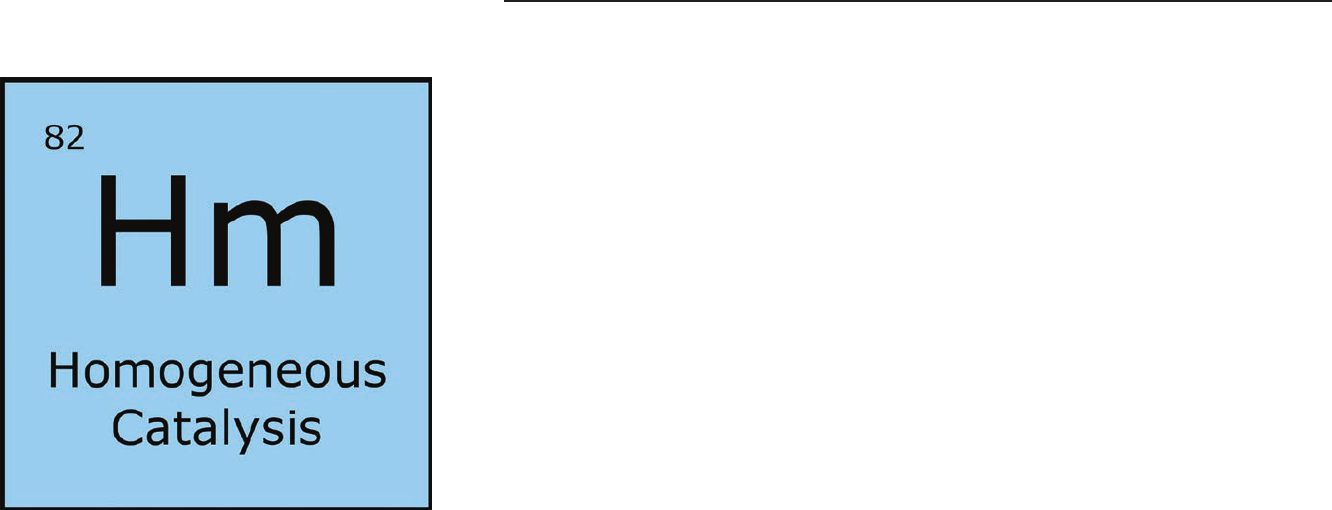
65
The Periodic Table of the Elements of Green and Sustainable Chemistry
Homogeneous Catalysis
When something is the same throughout and consists of all the same parts
it is homogeneous. In chemistry, this can refer to uniformity of composition,
but also mixtures of materials in the same state of matter (solid, liquid, or
gas). Homogeneous catalysts, in which the catalyst and reactant are in
the same phase, are at the heart of extremely important methods in green
chemistry. Due to the nature of homogeneous catalysts and the ability to
easily characterize how they function, they are relatively easy to design at
a mechanistic level for enhanced performance and can positively impact
health, leading to improved environmental outcomes.

66
The Periodic Table of the Elements of Green and Sustainable Chemistry
Degradation
Persistent substances may remain in their natural and man-made
environments for an indefinite time. These compounds may accumulate to
reach levels that are harmful to health, environment, and natural resources.
Such contamination may be poorly reversible or even irreversible, and
could render natural resources such as soil and water unusable far into
the future. As such, there is a need to design chemicals and materials,
particularly those that are intentionally or unintentionally distributed in the
environment, that are stable during their useful life, and then degrade once
they are no longer functionally necessary. Designing for degradation is
necessary but not sufficient to realize the goals of sustainable chemistry;
the subsequent degradation products should, themselves, be benign to
human health and the environment.

67
The Periodic Table of the Elements of Green and Sustainable Chemistry
Benign Metabolites
Metabolites are formed by degradation or transformation of chemicals in
a living organism. Metabolic processes in humans, plants, or any living
organism are relevant to sustainable chemistry. Metabolites may have
beneficial functions within an organism to regulate various processes, or
they may be inert. However, some can cause toxicity or adverse health
effects. Awareness of these process is important as sustainable design
must anticipate product breakdown and not just the product itself in order to
minimize harm to humans and the environment. Benign parent compounds
can produce harmful metabolites. This is especially relevant to biologically
active chemicals such as pharmaceuticals and herbicides or pesticides that
where small changes to chemical structure during physiological processes
could lead to unintended effects.

68
The Periodic Table of the Elements of Green and Sustainable Chemistry
Molecular Degradation Triggers
Molecular degradation triggers are events that strategically promote
breakdown of molecules. These could include chemical- or pH-sensitive
functional groups or UV light triggers. Today there are many stable
compounds that persist in the environment far beyond the desired lifetime
of the product. Molecules incorporating triggers could help prevent harmful
impacts that arise from chemical persistence, if designed to form benign
by-products following the intended end of life of chemicals and products.

69
The Periodic Table of the Elements of Green and Sustainable Chemistry
Degradable Polymers and Other Materials
For a chemical material to endure and persist beyond intended use serves
little purpose and has been the cause of serious problems. Polymers should
not be (effectively) immortal. Yet, many materials approach that level of
persistence when compared to the human time-scale. This has resulted in
well-known concerns for plastics in landfills and in the oceans. It also is of
concern for lesser-known issues such as the potential impacts of persistent
microplastics or water-soluble synthetic polymers that are being integrated
into ecosystems and the biosphere. Polymers can be designed such that
their entire lifetime is approximately the same as their useful lifetime.

70
The Periodic Table of the Elements of Green and Sustainable Chemistry
Prediction and Design Tools
Designing next generation chemicals and materials will require next
generation prediction and design tools. Analytical understanding and
computational models continue to be more powerful, allowing increased
insights to go beyond simply predicting potential adverse impacts toward
informing design. This is critical because predicting that something may
be harmful without a mechanistic basis for that model outcome does not
provide sufficient and necessary guidance to a chemist on how to redesign
the molecule to preserve function while minimizing or eliminating the
hazards.

71
The Periodic Table of the Elements of Green and Sustainable Chemistry
Measurement and Awareness
To know whether an action or invention is positive or negative for the world,
there needs to be some kind of feedback from the system. In the absence of
this feedback, there is little more than insufficient guesses and suppositions.
However, the way that we choose to measure the performance and impact
of our products, processes, and systems will often have a profound impact
on the understanding that we take away from these measurements.
(Even the compass is only two-dimensional.) If we are operating in multi-
dimensional systems like those involved with sustainability, we will need
measurement systems that are as multi-dimensional if we wish to gain
insight from them. Traditional, limited measurements such as efficiency
measures will be insufficient for this complex system. Additionally, our
measurement systems have often been retrospective tools that would give
us reports on what happened in the past, sometimes with long enough
lag times that the information itself is irrelevant. We now have tools and
computational abilities that can provide real-time insights and awareness
that allow for relevant action.

72
The Periodic Table of the Elements of Green and Sustainable Chemistry
Sensors
Chemical and chemo-electronic sensors can now provide a level of
detection and real-time awareness of factors and dynamics that were once
thought unknowable. With applications ranging from air and water quality
to health indicators to environmental ecosystems shift, the development
of ubiquitous, integrated sensors can provide data that inform insights into
planetary and human health. These same sensors can inform and empower
more efficient use of materials and energy in manufacturing and consumer
use. These approaches will be critical to maintaining a sustainable society.

73
The Periodic Table of the Elements of Green and Sustainable Chemistry
In-Process Control and Optimization
In manufacturing processes and operations, the way to verify smooth
operation was conventionally through periodic analysis, requiring extractive
testing and analysis of the product, often destructively. This approach
was time- and labor-intensive and led to waste materials and energy.
Often, product that did not meet specifications (so-called off-spec) would
need to be discarded as waste, frequently in large quantities. It is now
possible and important that future processes and even operations beyond
manufacturing utilize in-process control and optimization through the use
of real-time sensors and analysis. In this way, there is the ability to sense
off-spec material before it is formed in significant quantities and to make
the appropriate corrections in-situ. This becomes especially vital when
pursuing the goal of process integration.

74
The Periodic Table of the Elements of Green and Sustainable Chemistry
Exposome
The exposome refers to everything an individual is exposed to beginning
in utero through end of life. Each of these exposures can accumulate,
compound, and interact with each other and affect one’s health. Exposures
include anything from one’s environment, diet, workplace, and lifestyle. An
individual’s unique physiological characteristics and genetics can play a
major role in determining the effects of exposure. In terms of sustainability,
it becomes important to consider the potential exposures in the design
stage for any product or chemical. By better understanding the exposome
we can make design choices that improve safety and minimize harmful
exposures.

75
The Periodic Table of the Elements of Green and Sustainable Chemistry
Green Analytical Chemistry
Analysis of the air, water, and land to detect pollution was historically
conducted with field sampling protocols required and extensive effort
to transfer materials to specialized laboratories where extensive work-
up generated large volumes of solvents and waste. The processes of
measurement and analysis of an environmental problem often contributed
to other environmental problems. With the use of real-time, in-field
analysis, the necessary measurements can be taken without the wasted
time, material, and energy. This “green analytical chemistry” has been
extended to a wide range of analytical techniques beyond environment
analysis, reducing the quantity of materials needed and waste generated.
76
The Periodic Table of the Elements of Green and Sustainable Chemistry
Enabling Systems Conditions
Certainly, chemistry must not simply be a puzzle to be solved. Certainly, it’s not simply an
academic curiosity. It always has had the thread of purpose and impact to it. And because of the
understanding that when we introduce new things into the universe that the universe has never
seen, we need to anticipate the consequences. All of green chemistry and green engineering
has been focused on those parts of the endeavor. But in order to make that endeavor real, in
order to make those discoveries, those insights, those inventions, real, discoveries need to go
beyond the realm of science or technology.
The science and the technology may be essential. Without the science, advancement may not
be possible. But even with the discoveries, the inventions, and the innovations, advancement
is not going to happen alone with only science and technology. We recognize its that chemical
molecular transformations depend on different conditions: heat, pressure, light, stirring, mixing,
whatever it is. We need to think even more broadly about the system conditions that are
necessary in order to bring about the positive impact at societal scale, and what is the urgency
that is going to empower a sustainable transition, a transition to a sustainable world.

77
The Periodic Table of the Elements of Green and Sustainable Chemistry
Enabling Systems Conditions
In order to turn invention and innovation into implementation and impact, the wide range of
system conditions needs to be aligned

78
The Periodic Table of the Elements of Green and Sustainable Chemistry
Conceptual Frameworks
Conceptual frameworks provide a basis for considering the role of the
chemical enterprise in advancing sustainability and the associated
complexities.
Such frameworks provide a means to understand the relevant concepts as
well as their relationships to one another.
Frameworks of this nature help to inform the overarching design of the role
of chemicals and chemistry in contributing to the goals of a sustainable
future.

79
The Periodic Table of the Elements of Green and Sustainable Chemistry
Biomimcry
Nature has had a 3.5 billion-year head start on designing products,
processes, and systems and it shows. Nature is indescribably brilliant in
its ability to produce the widest range of chemicals and materials using
locally-available starting materials, usually at ambient temperatures and
pressures, completely eliminating the concept of waste, and doing it in a
way that is conducive to life. In the face of this ingenuity, the only wise
and sustainable strategy is to take Nature as a mentor and a guide in
designing human-made products and systems. The lessons to be learned
are limitless and the benefits to be had, essential.

80
The Periodic Table of the Elements of Green and Sustainable Chemistry
Circular Economy
Circular Economy refers to closing the material loop. This means working
to keep resources in use for as long as possible and requires both the
producer and consumer to be aware of how they are utilizing resources.
It can help to ensure waste and resources, at any point from production
to end of life of a final product, are reused, repaired, or recycled in some
capacity. This helps to decrease waste and becomes especially important
in sustainability efforts, helping companies to reduce waste, save money,
and work to ensure there is not depletion of finite resources. The concept
of circular economy should be considered in all phases of the product
life cycle and can not only help to save resources, but also decrease the
amount of toxic waste output.

81
The Periodic Table of the Elements of Green and Sustainable Chemistry
Benign by Design
“Performance” of a product, process, or system has been a concept that
has been narrowly defined in terms of how well something achieves a
very specific goal. Perhaps it’s a dye being a particular shade of blue or a
lubricant’s ability to reduce friction. While performance has been focused
on the desirable qualities, this has often come with undesirable or adverse
unintended consequences.
Benign-by-design builds all factors into the definition of performance such
that inherent safety is also included along with function.

82
The Periodic Table of the Elements of Green and Sustainable Chemistry
Industrial Ecology
Industrial ecology aspires to manage material and energy flows in the same
way that an ecosystem performs, with the aims of ultimately decreasing
environmental stress and improving resource efficiency. This can be done
by considering industrial processes as a closed loop as much as possible,
creating the opportunity to decrease inputs through the reuse of outputs
either within a facility or between different organization. By viewing waste
as a resource – by closing these material and energy loops – waste and
resource depletion caused by industry can be minimized. Industrial ecology
helps to find solutions to environmental problems by identifying problem
areas in business and industry and can aid in improved sustainability
practices.

83
The Periodic Table of the Elements of Green and Sustainable Chemistry
Trans-Generational Design
It has been shown that exposure to a chemical by one generation can have
deleterious effects on future generations, even without direct exposure
themselves. This is especially relevant to chemicals that interfere with the
body’s hormonal systems, leading to a variety of adverse health effects
including reductions in sperm counts as well as tumors, birth defects, and
other developmental disorders. In this way, the chemistry we practice and
the chemicals we produce today can have lasting and debilitating effects
on future generations. This emerging knowledge carries an enormous
burden of responsibility to be accountable not only to today’s population
but to those not yet born.

84
The Periodic Table of the Elements of Green and Sustainable Chemistry
Bio-Based Economy
Bio-Based Economy refers to the innovation in utilization of biomass to
sustainably make bio-based products such as chemicals, materials, fuel,
and energy. It is an attempt to move away from reliance on depleting
resources and rely on renewable, bio-based feedstocks. Traditionally,
chemicals have been made from petroleum feedstocks. Although chemical
production only accounts for 5%–7% of petroleum consumption, petroleum
sources represent over 98% of chemical feedstocks. The advantages for
moving to renewable feedstocks include an opportunity for innovation and a
chance to take advantage of nature’s ability to perform exquisitely selective
chemistry. Petrochemical feedstocks provide very simple hydrocarbons,
which chemists have learned to make more complex. Natural feedstocks
are inherently different. They are complex molecules, and chemists are still
developing elegant ways to efficiently transform them into useful products.

85
The Periodic Table of the Elements of Green and Sustainable Chemistry
Economics and Market Forces
Current global economic systems and market forces tend to drive perverse
incentives that have resulted in the design and evolution of our existing
chemical infrastructure.
These economic and market systems are critical and will either catalyze or
retard the implementation of our science and our technology. It is important
to recognize that in addition to traditional approaches of cost benefit
analysis, full cost accounting, risk analysis, or traditional metrics, we also
are going to need to understand factors including where investment models
are made, what kind of business models and business frameworks will be
either speeding up the adoption of Green Chemistry and Green Engineering
or rejecting it no matter how transformative it may be, and how do we
integrate these economic and market forces in order to accelerate and have
our technologies adopted.
These powerful drivers can be harnessed to encourage behavior and
decision-making that is aligned with the goals of a sustainable future.

86
The Periodic Table of the Elements of Green and Sustainable Chemistry
Life Cycle Cost-Benefit Analysis
Cost-Benefit Analysis is a decision-making process that helps to identify
and quantify the costs and benefits associated with all potential scenarios
or options. It is a systematic approach to estimating the strengths and
weaknesses of alternatives used to make decisions between alternatives.
Opportunity cost, the benefit missed by choosing one option over the
other, is often also factored into the analysis. It can be used to compare
intangible items, such as ecosystems services or the benefit of choosing
an option that confers less environmental and negative health impact over
a more detrimental option. In sustainability practices, cost-benefit analysis
can help to identify options that may confer more favorable environmental
conditions, while also minimizing costs over the entire life cycle. It is
important to consider the full life cycle in this type of analysis as costs may
be higher upfront for greater benefits later on.

87
The Periodic Table of the Elements of Green and Sustainable Chemistry
Full Cost Accounting
Full cost accounting allows for the implementation of environmental, health,
and social assets to be considered in the economic costs and benefits
of decision making. It allows for complete end-to-end cost analysis of
producing products or services. The goal is not necessarily to monetize their
value, but rather to better understand their impact on an ecosystem and
society, and potential ability to create value. Full cost accounting can help
in sustainability by identifying areas where reducing environment impact
could create value and confer monetary and non-monetary benefits that
can be translated into economic terms. It allows for better management of
the natural and social resources in our world today and a way to achieve
more sustainable outcomes.

88
The Periodic Table of the Elements of Green and Sustainable Chemistry
Harm Charge / Carbon Tax
Carbon tax is a tax placed on the burning of fossil fuels, or carbon-based fuels,
and corresponds to greenhouse gas emissions. The fee is either placed on
the producers or passed along to the consumers for the carbon emissions
produced from the burning of fuel. It can be implemented in a number
of different facets such as through costs associated with home heating,
flights, and shipping capacities. A harm charge is a similar concept only
less specific. It places a charge on any practice harmful to the environment
or human health such as a chemical spill, using non-sustainable products,
or water pollution. The charges or taxes are utilized in order to serve as
a disincentive to practices harmful to the climate, the environment, and
human health, helping to shift thinking toward more sustainable practices.
Further, the revenue generated from these charges can be used to invest in
sustainability practices elsewhere in the system.

89
The Periodic Table of the Elements of Green and Sustainable Chemistry
Depletion Charge
Similar to harm charge, depletion charge presents an opportunity to
internalize an externality. In this case, the externality is the consumption of
finite resources. Depletion charge presents an opportunity to incrementally
increase the economic cost associated with the use of a finite resource by
factoring in scarcity. That is, using the next amount of a finite resource
would be increasingly expensive to disincentivize its ongoing use. This
incremental charge does not need to be linear, and could itself increase
with ongoing use of the finite resource, rapidly leading to a price that is cost
prohibitive, rendering that finite resource economically infeasible.

90
The Periodic Table of the Elements of Green and Sustainable Chemistry
Sustained Research Funding
Scientific investigations, studies, and breakthroughs will be necessary
to move away from the unsustainable trajectory that we are on. These
investigations, in many cases, may require sustained efforts either due to
the difficulty of the challenge or the inherent nature of longitudinal insights.
These research efforts are particularly fragile to disruptions caused by
the unpredictable modalities of research funding schemes whether in the
public or private sector. The imperative of sustained, predictable funding
support will be an essential element of achieving the kinds of insights and
inventions necessary for sustainable prosperity.

91
The Periodic Table of the Elements of Green and Sustainable Chemistry
Capital Investment
The chemicals and material manufacturing infrastructure that makes
everything from building materials to wind turbines is very capital intensive.
Current schemes for capital investment (e.g., venture, private equity), have
the common goal of achieving targeted returns while minimizing risk.
This model significantly favors incrementalism which makes it far easier
to understand and analyze the risk profile for technological investments.
It also favors low capital-intensive projects such as software and “app”
projects and disfavors projects such as large-scale infrastructure and
manufacturing. Achieving sustainability goals necessitates transformative
technologies and dramatically reconstituted sustainable infrastructure
at unprecedented scale requiring wise, patient capital at a significantly
increased level.

92
The Periodic Table of the Elements of Green and Sustainable Chemistry
Metrics
For metrics to be useful in sustainability, they must have attributes that
reflect sustainability itself. They must be both quantitative and qualitative.
Looking at the historical metrics, and the way that professions often
“worship at the altar” of efficiency metrics, it often seems that society has
outsourced our decision making to quantifiable reductionist metrics. When
thinking about achieving sustainability goals, we need to far exceed those
simplistic metrics, and couple them with a more qualitative, and often,
uncomfortable new generation of metrics. These metrics will move beyond
mere quantities and instead provide insights into the character and inherent
nature of our energy sources, of our stored energy storage systems, of our
materials, and our basic chemicals. Sustainable metrics must be applicable
and relevant across time and space, systems-based, and able to combine
both reductionism and integrative systems thinking.

93
The Periodic Table of the Elements of Green and Sustainable Chemistry
Atom Economy
Measuring the efficiency of chemical reactions is necessary to compare
alternative synthetic routes to products in terms of environmental and
economic costs. Percentage yield has historically served this function, as it
compares the (predicted) theoretical and actual product quantity. However,
a high yield is not sufficient to identify environmentally-preferable synthetic
routes because there can be significant waste generated in a reaction that
produces close to the predicted amount of product. As such, we need an
additional metric, atom economy, to measure how much of the reactant
atoms actually form the final product whereby:
This is effectively guiding a chemist to pursue pollution prevention at the
molecular scale. The higher the atom economy, the lower the amount of
waste product formed. Both the yield and the atom economy should be
taken into account when designing a green chemical process.

94
The Periodic Table of the Elements of Green and Sustainable Chemistry
E-Factor
The amount of waste produced in the manufacture of a chemical product
or a product of any kind should be minimized. While one would intuit that
this measure was always part of manufacturing efficiency, it was not. The
introduction of the calculation of the E-Factor took the original form of:
and can be adjusted to include a variety of aspects of the manufacturing
process. E-factor provides information that was historically neglected but
is critical to moving toward more efficient and effective chemical production.

95
The Periodic Table of the Elements of Green and Sustainable Chemistry
F-Factor
No one ever bought a chemical. They bought function or performance.
They wanted the service the chemical provided. With that realization, a
metric, F-Factor, has been developed to recognize and quantify the desire
to achieve maximum function with the minimal amount of chemical used.
This approach has been expanded in the discussions of the chemical
equivalent of Moore’s Law.
The desire is for the value of F to be as large as possible by increasing
the functional performance and/or decreasing the amount used to achieve
some functional performance. This drives the system toward ideality where
you get all of the function of a chemical or product without the existence of
a chemical or a product; the chemical analogy of getting the function of the
telephone without the need for telephone wires on every street.

96
The Periodic Table of the Elements of Green and Sustainable Chemistry
Qualitative Metrics
While most of traditional assessment is based around quantitative metrics,
qualitative metrics may be equally necessary in providing understanding
related to sustainability. The nature and the character of aspects of sustainable
chemistry are not always reductionist exercises. The renewability of a
feedstock, the toxicity of a molecule, the environmental justice implications
of siting a factory, market acceptance of an energy technology etc., may
all have qualitative aspects that are critically important. While qualitative
metrics may be less rigorous and involve integrative systems thinking that
is outside traditional analytical frameworks, it is possible that they are more
closely linked to the interconnected nature of sustainability systems and
goals as outlined in the United Nations Sustainable Development Goals.

97
The Periodic Table of the Elements of Green and Sustainable Chemistry
Quantitative Metrics
One of the most active areas in analytical tools related to green chemistry
and engineering is that of quantifiable metrics. There are important
measures of (process) mass intensity ((P)MI), reaction mass efficiency
(RME), carbon efficiency (CE), innovative green aspiration level (iGAL),
and others. These quantifiable metrics can be useful and informative in
answering specific questions of efficiency and environmental impact
when a reductionist analysis is necessary to inform improvement. It is as
important to know what data or information the quantifiable metrics are
providing as it is to understand what questions they aren’t addressing. The
strengths of quantifiable metrics are essential and their weaknesses must
be equally respected.

98
The Periodic Table of the Elements of Green and Sustainable Chemistry
Chemical Body Burden
Chemical Body Burden refers to the measurement or load of chemicals in the
body. This load can be detected through blood, urine, breastmilk sampling
or any number of biomonitoring activities. Chemicals in the body could
have numerous harmful effects and could weaken the immune system,
making the body more susceptible to disease. The burden may be due to
bioaccumulation through various mechanisms of exposure. Understanding
the amount and types of chemicals in the body can help us know what
chemicals are mobile in the environment. Chemical Body Burden is
important to sustainability because it can make known the chemicals with
the greatest bioaccumulation in nature and greatest exposures to humans,
helping to inform future design of chemicals and products that avoid these
unintentional impacts.

99
The Periodic Table of the Elements of Green and Sustainable Chemistry
Policies and Regulations
The landscape of technologies in the chemical enterprise is not merely
shaped by scientific and engineering solutions alone but rather in
combination with the environment of regulation, policies, and laws that
construct the social context in which they operate.
Policies and regulations can accelerate or retard sustainability solutions and
they can protect or help displace entrenched unsustainable technologies.
The development of regulations and policy that will empower and enable
green chemistry and green engineering to succeed in society will be
necessary to remove the obstacles and inertia that keep the status quo in
place.

100
The Periodic Table of the Elements of Green and Sustainable Chemistry
Extended Producer Responsibility
Extended Producer Responsibility refers to the responsibility a producer
holds to design their product in a way that reduces negative environmental
and health impact. It also places end-of-life management on the producer
and not the consumer. This is especially important to sustainability. If the
producers, who are responsible for what the environment and the population
is exposed to, are not held responsible for ensuring their products are healthy
and environmentally friendly, it becomes a problem of remedy rather than
stopping it at the source. Extended producer responsibility helps to manage
and mitigate end-of-life waste and all pollution generated from products at
all stages of its life cycle.

101
The Periodic Table of the Elements of Green and Sustainable Chemistry
Property-Based Regulation
The history of chemical regulation involved constructing lists of chemicals
that were considered too hazardous or too risky and imposing some types
of controls on them. Chemical-by-chemical regulation is slow, costly,
inefficient, and inadequate. The nature of the concern for a chemical is
not based on its chemical name but rather on its combination of properties.
Some combinations of properties may lead a chemical to be bioavailable,
others to be persistent, still others to be reactive or explosive. Since it is the
combination of these properties that cause the concern, it is the properties
that should be the basis of regulation. In this way, the chemicals of concern
can be addressed proactively while providing certainty to the regulated
community and critical guidance to the molecular designers of future
products.

102
The Periodic Table of the Elements of Green and Sustainable Chemistry
Chemical Transparency
Chemical transparency refers to the disclosure of all chemicals and
ingredients in all products. This is becoming exceedingly important among
consumers. Consumers want to know what is in their chemical products
and as part of their decision to trust the brands they use. This pressure from
consumers and government can help to hold manufacturers accountable
and aid in the development of safer, more benign chemicals, and continually
move toward developing more sustainable products. Not only does this
give consumers the option to choose safer, more environmentally-friendly
products, but it also allows for easier and better exchange of practices among
different companies. There are significant efforts underway to standardize
the reporting of chemical ingredients in a variety of products to aid in data
collection and product comparison.

103
The Periodic Table of the Elements of Green and Sustainable Chemistry
Chemical Leasing
There is very little value to the ownership of the vast majority of chemicals
unless they are used for their intended purpose. And yet, because of the
traditional sell/own business model, the waste that results from over-
purchasing is significant and systemic. Further, the system is constantly
driving toward selling more chemicals to make more profit, driving toward
designed obsolescence and short-term use. The chemical leasing model
is one where the “sellers” supply the service or function rather than selling
a chemical. In this model, instead of selling as much chemical as possible
(resulting in excess and waste), the motivation is to use as little of a chemical
to accomplish the desired service as the same profit can be generated from
delivering much less product. Chemical leasing is a business model whose
effectiveness has been demonstrated at large scale and has extensive
potential to be expanded.

104
The Periodic Table of the Elements of Green and Sustainable Chemistry
Self-Enforcing Regulations
The idea that regulations and laws to protect the environment and human
health can be effectively enforced by government inspectors and officials
has been belied by experience. This historical model has demonstrated
over the past half-century that most of the damage is not detected and
when it is detected it is at a timeframe that is inadequate to prevent the often
tragic consequences. With the advent of sensors, real-time in-process
controls, big-data analysis, and machine-learning, it is now possible to
rethink models for enforcement. Instead of sampling hazardous waste sites
for laboratory analysis to determine levels of contamination, there are now
possibilities for integrated, networked monitoring systems. New processes
can be designed such that they only can function as long as emissions are
below certain levels for various contaminants. The emerging field of self-
enforcing regulations can also build in predictability and reduced economic
and time burden for the regulated community while ensuring enhanced
effectiveness in achieving the goals of the regulation.
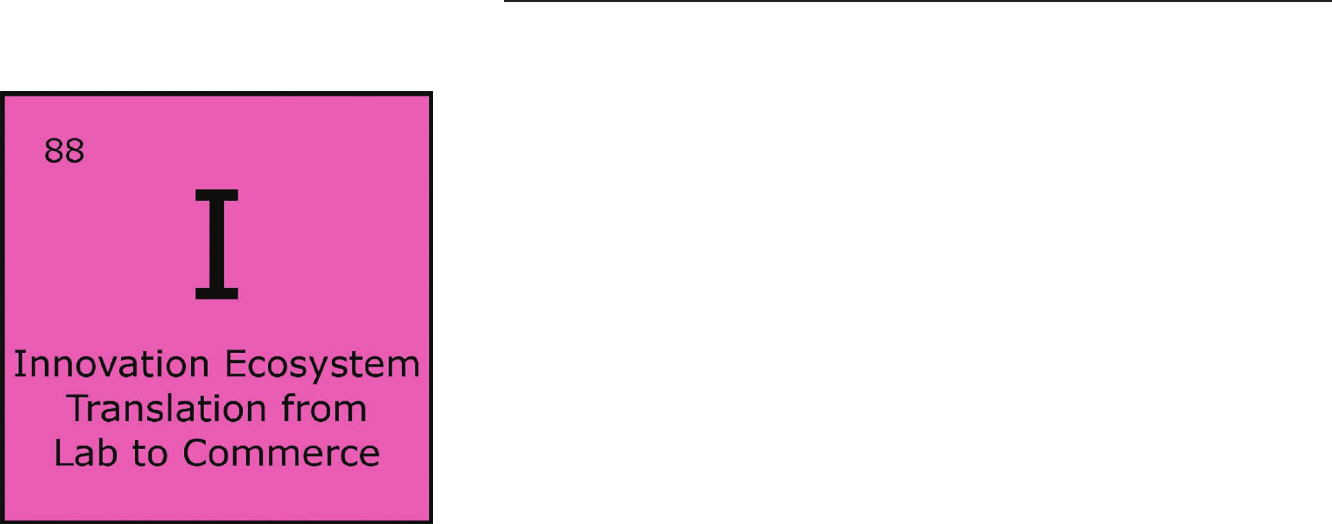
105
The Periodic Table of the Elements of Green and Sustainable Chemistry
Innovation Ecosystem - Translation from Lab to Commerce
In order for a discovery or innovation to have an impact on the world, it
virtually always needs to be enabled by an innovation ecosystem that
incorporates the essential enabling elements. These include support for
basic research and development and that R&D needs to be commercialized
through thoughtful and risk-taking investment. These roles can be filled by
various actors ranging from public sector government agencies to private
sector investors. Appropriate and just intellectual property considerations
need to be supported by governance and returns on investment need
to be realized through adequate financial systems. With key roles and
responsibilities assured, the innovation ecosystem can be used to bring
about the transformative innovations in the chemical enterprise that are
needed to advance sustainability.

106
The Periodic Table of the Elements of Green and Sustainable Chemistry
Tools
Increasing the development of tools to enable Green Chemistry and Green
Engineering has expedited the adoption of more sustainable choices in the
selection and innovation of products and processes. These resources allow
chemists, engineers, and other professionals to pursue the incorporation of
green chemistry into a wider range of products and processes with greater
confidence in their decision-making and more credibility in building the
business case for implementing these innovations.

107
The Periodic Table of the Elements of Green and Sustainable Chemistry
Epidemiological Analysis and Ecosystem Health
Epidemiological Analysis refers to the understanding and analysis of how
different populations are affected by various risk-factors, disease, and other
health outcomes. Ecosystem Health refers to the health or condition of
the environment and all living organisms in that environment. That is, its
susceptibility/resiliency to natural disaster and ability to sustain life defined
by a number of indicators unique to the ecosystem. In conjunction, these
two concepts define the health of an area and all the living organisms
within it. These concepts are key to sustainability because they define the
successfulness of sustainability practices. If something is being carried
out in an unsustainable way it will be directly reflected in the health of the
population and environment.

108
The Periodic Table of the Elements of Green and Sustainable Chemistry
Alternatives Assessment
Alternatives Assessment is a technique aimed at minimizing harm by
assessing all options and solutions and understanding the consequences
of each. It helps to characterize hazard based on health and environmental
information. It is often utilized in risk assessment and as a decision-making
approach. One common application is a chemical alternatives assessment
in order to aid in choosing the safer chemical over a more hazardous one
with the aim of avoiding regrettable substitution.

109
The Periodic Table of the Elements of Green and Sustainable Chemistry
Life Cycle Assessment
Life Cycle Assessment determines the total environmental impact of a
product from beginning to end of life, or cradle-to-grave. This is done
through accounting for all material and energy-related inputs and outputs
throughout the life of a product. It helps to measure all steps of production
and use, and their subsequent environmental and health implications. Life
Cycle Assessment provides a producer information for all direct and indirect
environmental impacts associated with their products and processes,
illuminating areas for improved design choices or making decisions between
one chemical product or process and another.

110
The Periodic Table of the Elements of Green and Sustainable Chemistry
Solvent Selection Screens
Solvents are often critical to a chemical process as a medium in which to
facilitate contact of reactants and manage energy flows. They are also often
the deciding aspect in the cost and environmental impact of a chemical
process. However, when it comes to choosing the right solvent there
are often many options, all which have different properties and different
environmental impacts. A solvent selection tool identifies different solvent
options using a variety of statistical, regression, and structure/property-
based strategies, and then provides comparisons through various graphical
outputs and shortlists. It allows the user to apply filters that select for certain
properties and pick the best possible solvent for the situation. It also can
aid in sustainability through improving industrial process and aiding in the
evaluation of solvents in regard to their environmental and health impact.

111
The Periodic Table of the Elements of Green and Sustainable Chemistry
Chemical Footprinting
Chemical Footprinting allows for comprehensive, full life cycle management
of chemicals being used by companies today. It gives companies the tools
and ability to better understand what chemicals are in their products and
a metric to better manage the safety and environmental impact of those
chemicals. This benchmarking tool is important in sustainability practices
because it helps to create a common standard for all to follow, while also
reducing chemical risk, identifying areas for improvement, and measuring
the progress being made.

112
The Periodic Table of the Elements of Green and Sustainable Chemistry
Education in Toxicology and Systems Thinking
In most professions, the people that create something have responsibility
for the safety of what they create. This is not true in the field of chemistry.
All chemists need to understand the consequences to the world and
its inhabitants of what they create and study. Yet, virtually no training
programs for chemists include the requirement of a course in molecular
toxicology. The basic principles of chemical dose-response, bioavailability,
bioaccumulation, and biomagnification need to be understood by chemists
as well as the molecular level understanding of the fundamentals of acute
and chronic toxicity, carcinogenicity, and endocrine disruption, among all
relevant human health endpoints.
113
The Periodic Table of the Elements of Green and Sustainable Chemistry
Noble Elements
Molecular scientists have been given the gift of the ability, the knowledge, the capability, the
awareness, and the intellect to manipulate matter, to transform it from one thing to another,
to give it different properties. Most of that gift does not come from us, it’s not due to us. It is
through birth, through opportunity, through circumstance and yes, a little hard work that we are
given the gift of insight of chemistry. With that gift comes responsibility; we no longer have the
option to say, “I don’t care.” We no longer have the option to say, “I don’t know.” We no longer
have the option to say, “This is not relevant to me.” Because we do and it is. And with that level
of awareness, we have that responsibility. And these are our noble, not Nobel, our noble goals
that we need to strive toward. It is with this knowledge that we must act.

114
The Periodic Table of the Elements of Green and Sustainable Chemistry
Noble Goals
There are some concepts that are transcendent. These considerations
rise above the immediate economic or political concerns of the day. Noble
elements are those that are grounded in moral imperatives that are shared
across cultures and across time. These elements find their basis in values,
justice, and trans-generational equity. Chemistry can impact all of these
issues either positively or negatively and therefore these goals must
consciously enter into our decision-making and our designs.

115
The Periodic Table of the Elements of Green and Sustainable Chemistry
Hippocratic Oath for Chemistry
First, do no harm. The products that are made and the processes that make
them and the resources that they come from will do no harm to the planet,
both the biosphere that occupies it and the geosphere that sustains all
living things. There will be no harm to the workers obtaining the feedstocks
and transforming them, to the consumers using them, to the communities
and populations, human and non-human alike, that may be exposed to
them. There will be as much thought and care put into the consequences of
chemistry as there is into the design and invention of the chemistry.

116
The Periodic Table of the Elements of Green and Sustainable Chemistry
Design for Posterity
We borrow this planet and everything that is in it from the future. We own
nothing. We owe everything. Our debt is repaid through the care exhibited
by thoughtful use and design. Perpetuating flawed unsustainable systems
based on limited knowledge or short-sighted perspectives is design for the
past which simply enshrines ignorance and errors.
Constant change to reflect the highest levels of awareness that can lead to
a more sustainable world is the path toward being respected by the future
and ensuring that there will be a future to be respected by.
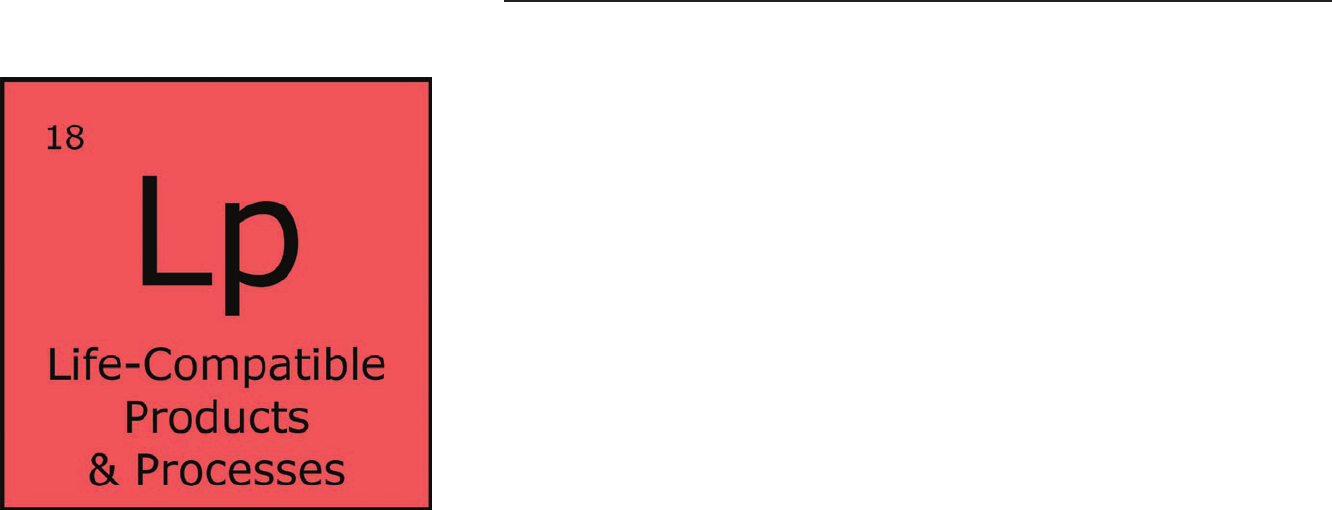
117
The Periodic Table of the Elements of Green and Sustainable Chemistry
Life-Compatible Products & Processes
Nature is conducive to life. We are part of Nature and must assume our role
as being conducive to life. The chemistry we discover and the chemicals we
introduce into the world must reflect this role. The idea of legally acceptable
toxicity and poisoning, socially acceptable degradation of ecosystems,
and tolerable rates of species extinctions are frameworks that are flawed,
illogical, and incompatible with our role in Nature.

118
The Periodic Table of the Elements of Green and Sustainable Chemistry
Zero Waste
Waste is a man-made concept. In Nature outside of man, there is no
waste. Evolutionary brilliance ensures that the waste from one organism
will be utilized at high value to another organism. Waste in our chemical
and material world is simply a material or energy for which a valuable
use has not been discovered or implemented. While we will never defeat
thermodynamics in attaining perfect cycles and entropy will always win,
the cycles and systems that can be constructed can strive to continuously
move toward the perfect goal of zero waste.

119
The Periodic Table of the Elements of Green and Sustainable Chemistry
Chemistry is Equitable and Fully Inclusive
The natural laws of chemistry have no predisposition to any gender, race,
creed, religion, nationality, ability, nor orientation. Yet the participation
within the chemical enterprise has historically been dominated by a small
demographic sliver of the population. The science and application of
chemistry can only benefit by a maximum breadth of perspectives, skills,
experiences, cognitive approaches, and values of a diverse community with
a culture of inclusion. No endeavor, scientific or otherwise, can be 100%
effective if it excludes so much of its talent. It would be as absurd to limit
participants of a scientific field to individuals of a certain height or weight as
it would be to limit them by their gender or ethnic background.
Full inclusion of all groups in the chemical enterprise should be pursued
as a pathway to genuine excellence and not merely the narrow historical
definitions of excellence as posited by those who have historically
dominated the field.

120
The Periodic Table of the Elements of Green and Sustainable Chemistry
Benefits Distributed Equitably
The benefits of chemistry are immense and have revolutionized the quality
and length of human life. But not for everyone. The benefits of chemistry and
chemicals are not distributed equally. Large percentages of the population
have borne the burdens of a chemical-intensive society where the smallest
percentage of the population has received benefits with virtually no burden.
Through thoughtful green and sustainable chemistry, new products will
be agile, accessible, and adaptable and thus able to benefit people in the
widest possible range of demographics, geographies, socio-economic, and
logistical circumstances

121
The Periodic Table of the Elements of Green and Sustainable Chemistry
Extraordinary Chemical Knowledge Comes with
Extraordinary Responsibility
A diminishingly small percentage of the population has the knowledge and
understanding of how to manipulate matter at the molecular level. Those
possessing this knowledge came to it through a confluence of the gift of
sufficient intellectual capacity and the good fortune of having access to
some type of educational framework not of their making. The power of
chemistry is daunting and world-changing. It impacts societies, oceans,
and atmospheres.
With these two gifts comes a responsibility to use the power of molecular
manipulation for good and not ill. To build and not destroy. To heal and not
to harm.
122
The Periodic Table of the Elements of Green and Sustainable Chemistry
Valency
Every chemist knows about “valency.” Valency – electronic structures that make the forming
of bonds possible –– is critical to making molecules. But valency has another definition: “the
capacity of one person or thing to react with or affect another in some special way as attraction
or the facilitation of a function or an activity.” As we reflect on the elements of the Periodic
Table of Green and Sustainable Chemistry, how can we make the elements react? Professional
communities and social structures are often oriented around individual elements, from catalytic
chemists to policy makers. In what ways are we going to facilitate the reaction with other
elements? In what ways are we going to form these new bonds? In chemistry, covalency and
covalent bonding is the essence of sharing; a sharing of each to form a better, stronger whole.
What are these new molecules that will be formed? What are the new molecules that are being
formed by these bonds?
123
The Periodic Table of the Elements of Green and Sustainable Chemistry
Conclusion
The Periodic Table of the Elements of Sustainable and Green Chemistry is not complete, and
perhaps never will be. Just as Mendeleev’s table had many gaps when it was introduced in
1869, this table, too, has unknown elements yet to be discovered. Every element is and will be
critically important as we strive to realize the noble goals.
To attain the full power and potential of chemistry to improve the world, we need to begin with
the fundamental science of green chemistry and green engineering and implement all of the
tools, frameworks and perspectives contained in the elements of sustainable chemistry. You
cannot achieve sustainable chemistry without green chemistry. Green chemistry will not be
implemented at scale without the other elements of sustainable chemistry. Like all human
endeavors and actions, all of these efforts in chemistry need to take place within an ethical,
humanitarian, and moral framework. Just like the countless possible substances of the known
universe are comprised of the known elements of the Periodic Table, there are countless
possible paths to a sustainable future when employing the elements of green and sustainable
chemistry.
124
The Periodic Table of the Elements of Green and Sustainable Chemistry
Bibliography
Anastas, P. T. and Warner, J. C.; Green Chemistry: Theory and Practice, Oxford University
Press, 1998.
Anastas, P. T. and Zimmerman, J. B.; Design through the 12 principles of green engineering,
Environ. Sci. Technol., 2003, 37, 94A–101A
Anastas, P. T. and Zimmerman, J. B.; The periodic table of the elements of green and sustainable
chemistry. Green Chemistry. 2019;21(24):6545-66.
Benyus, J. M.; Biomimicry: Innovation inspired by nature, Morrow, New York, 1997.
United States Department of Health and Human Services, Centers for Disease Control and
Prevention; Fourth Report on Human Exposure to Environmental Chemicals, 2009.
MacArthur Foundation; Towards the Circular Economy volumes 1-3, 2012-2014.
National Research Council; A framework to guide selection of chemical alternatives. National
Academies Press, 2014.
Poliakoff, M., Licence, P. and George, M. W.; A New Approach to Sustainability: A Moore’s Law
for Chemistry, Angew. Chem., Int. Ed., 2018, 57, 12590–12591.
125
The Periodic Table of the Elements of Green and Sustainable Chemistry
Sheldon, R. A.; The E factor 25 years on: the rise of green chemistry and sustainability, Green
Chem., 2017, 19, 18–43
Trost, B. M.; The atom economy–a search for synthetic efficiency, Science, 1991, 254, 1471–
1477
United National International Development Organization; Chemical Leasing: Global Promotion
and Implementation of Chemical Leasing Business Models in Industry, Vienna, 2016.
United Nations General Assembly; Transforming our world : the 2030 Agenda for Sustainable
Development, A/RES/70/1, 2015.
126
The Periodic Table of the Elements of Green and Sustainable Chemistry
Access to Safe and Reliable Water, 13
Additive Synthesis, 35
Alternatives Assessment, 110
An Individual’s Molecular Code Belongs to that Individual,
22
Appropriate Technologies for the Developing World, 11
Aqueous and Biobased Solvents, 48
Atom Economy, 32, 95
Benefits Distributed Equitably, 123
Benign by Design, 83
Benign Metabolites, 68
Bioavailability / ADME, 45
Bio-Based Economy, 86
Biologically-Enabled Transformation, 61
Biomimcry, 81
Capital Investment, 93
Carbon Dioxide and other C1 Feedstocks, 59
Catalysis, 62
C-H Bond Functionalization, 40
Chemical Body Burden, 100
Chemical Footprinting, 113
Chemical Leasing, 105
Chemical Transparency, 104
Chemistry for Benign Food Production and Nutrition, 14
Chemistry for Sustainable Building and Buildings, 21
Chemistry for Wellness, 12
Chemistry is Equitable and Fully Inclusive, 122
Chemistry to Preserve Natural Carbon and Other
Biogeochemical Cycles, 16
Circular Economy, 82
Computational Models, 44
Conceptual Frameworks, 80
Degradable Polymers and Other Materials, 70
Degradation, 67
Depletion Charge, 91
Design for Posterity, 119
Index
127
The Periodic Table of the Elements of Green and Sustainable Chemistry
Design Guidelines, 43
Design to Avoid Dependency, 18
Earth Abundant Metal Catalysis, 64
Economics and Market Forces, 87
Education in Toxicology and Systems Thinking, 114
E-Factor, 96
Enabling Systems Conditions, 78
Energy, 52
Energy and Material Efficient
Synthesis and Processing, 53
Energy Storage and Transmission Materials, 55
Ensure Access to Material Resources for Future
Generations, 19
Ensure Environmental Justice, Security,
and Equitable Opportunities, 15
Enzymes, 63
Epidemiological Analysis and Ecosystem Health, 109
Exposome, 76
Extended Producer Responsibility, 102
Extraordinary Chemical Knowledge Comes
with Extraordinary Responsibility, 124
F-Factor, 97
Full Cost Accounting, 89
Green Analytical Chemistry, 77
Green Chemistry and Green Engineering, 25
Harm Charge / Carbon Tax, 90
Heterogeneous Catalysis, 65
High Throughput Screening
(Empirical / In Vivo / In Vitro), 46
Hippocratic Oath for Chemistry, 118
Homogeneous Catalysis, 66
Humanitarian Elements, 10
Industrial Ecology, 84
Inherent Safety and Security, 41
Innovation Ecosystem, 107
In-Process Control and Optimization, 74
In-Situ Generation and Consumption of Hazardous
Materials, 39
Integrated Biorefinery, 58
Integrated Processes, 34
Ionic Liquids / Non-Volatile Solvents, 49
Less Hazardous Synthesis, 37
Life Cycle Assessment, 111
128
The Periodic Table of the Elements of Green and Sustainable Chemistry
Life Cycle Cost-Benefit Analysis, 88
Life-Compatible Products & Processes, 120
Measurement and Awareness, 72
Metrics, 94
Molecular Codes of Nature Belong to the World, 23
Molecular Degradation Triggers, 69
Molecular Design, 42
Molecular Self-Assembly, 33
No Chemicals of War or Oppression, 17
Noble Elements, 116
Non-Covalent Derivatives /
Weak Force Transformation, 36
One-Pot Synthesis, 29
Policies and Regulations, 101
Prediction and Design Tools, 71
Prevent Waste, 27
Process Intensification, 30
Property-Based Regulation, 103
Qualitative Metrics, 98
Quantitative Metrics, 99
Reduce Use of Hazardous Materials, 38
Renewable / Carbon-Free Energy Inputs, 54
Renewable Feedstocks, 57
Self-Enforcing Regulations, 106
Self-Separation, 31
Sensors, 73
Smart Solvents (Obedient, Tunable), 51
Solvent Selection Screens, 112
Solvents/Auxiliary Chemicals, 47
Sub- and Super-Critical Fluids, 50
Sustained Research Funding, 92
Synthetic Biology, 60
Tools, 108
Trans-Generational Design, 85
Transparency for Chemical Communication, 20
Valency, 126
Waste Energy Utilization and Valorization, 56
Waste Material Utilization and Valorization, 28
Zero Waste, 121
